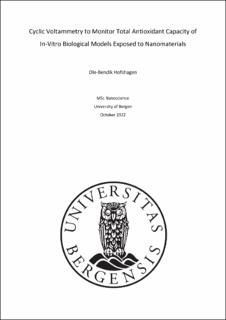| dc.description.abstract | The expanding field of nanotechnology has provided novel applications in many different areas including medicine and dentistry due to the unique properties exhibited by nanoparticles (NPs). However, various types of NPs have been shown to generate excessive amounts of reactive oxygen species (ROS), a known cause of oxidative stress, and consequently of toxicity. The increasing number of NPs in consumer products has led to an urgent need to assess their potential toxic effects. Traditional colorimetric and fluorescent-based methods used to evaluate oxidative stress have been shown to suffer from NP-induced interferences. Therefore, there is need for label-free methods to determine toxicity of NPs. The purpose of this study was to implement CV as a label-free method to assess the oxidative properties of NPs using screen-printed electrodes (SPEs). Additionally, A549 adenocarcinoma human alveolar basal epithelial cells were exposed to TiO2-, CeO2- and Ag-based NPs at concentrations of 10, 20, 50 and 100 µg/ml to evaluate the viability of cells supplemented with ascorbic acid (L-AA) and 2-phospho-L-ascorbic acid (2-P-AA) using label-free impedance-based monitoring (xCELLigence). Additionally, the NPs’ ability to induce ROS was assessed using a fluorescent-based method. Furthermore, images of exposed cells were captured using transmission electron microscopy (TEM) to make a qualitative assessment of NP uptake and internalization. Finally, steps were taken to fabricate cost-effective electrodes for CV by printing conductive inks on polyethylene terephthalate (PET) films. The results of the studies showed that several NPs have the potential to lower the total antioxidant capacity (TAC), especially AgNW, 3.5 nm CeO2, 8 nm TiO2 and TiO2 nanorods. However, the difference was not statistically significant at the timepoints used but may show significance over longer time periods. At the highest concentration, only AgNW and 8 nm TiO2 induced a significant difference in viability between samples containing L-AA and samples without L-AA, while for 8nm TiO2 this was seen at 50 µg/ml. Among the particles tested using fluorometry, only 3.5 nm CeO2 had a significantly increased ROS production compared to control. The 50 nm AgNPs displayed a quenching effect of the fluorescence signal and thus no results could be obtained for these particles. TEM images revealed a significant cytosolic uptake of all NPs, especially for 3.5nm CeO2 and CeO2 stamps. Furthermore, fabrication of cost-effective electrodes gave promising results, but will need further optimization. These methods seem to provide a reasonable estimation of oxidative properties of NPs. However, more testing is required to solidify its validity. In conclusion, CV emerged as a promising label-free method for assessing oxidative stress caused by NPs, with little to no interference from the NPs., whereas NP interference with a fluorescence-based method was observed. The AgNWs, TiO2 nanorods and 3.5 nm CeO2 NPs exhibited the highest intrinsic oxidative potential. All Ag-, TiO2-, and CeO2-based NPs used in this project possessed size- and shape-dependent oxidative effect and toxicity. | |
